
Information on the fire resistance of NOVATOP wooden structures
Although we already know very well how wood burns and how it behaves under high temperatures, there are still many questions that remain unanswered even today. It is certain that methodologies for calculating fire resistance will be increasingly applied in practice; however, with the development of new materials, testing will always be necessary. These tests will allow us to map their behavior in detail, and the properties discovered will then be "recomposed" into the language of numbers and formulas.
Current methodologies for assessing the fire resistance of structures are coordinated at the European level, and today no one can dispute their validity. However, the fact remains that the fire resistance determined by the test itself is always higher than the value determined by calculations. This is due to a number of elements included in the calculations, which are designed to ensure that the results are "on the side of safety." The most advantageous strategy, in this respect (considered in economic terms), appears to be conducting a fire resistance test on the basic structure and then "calculating" additional variants of compositions through calculation.
At the turn of May and June 2010, fire resistance tests of NOVATOP wall constructions were conducted in several variants, which accurately confirm the information above. The results obtained significantly exceeded expectations.
Based on careful preparation and a series of consultations with leading experts in the field, several compositions of constructions were selected. These compositions, with their excellent results, can open the door to other types of buildings, such as residential, industrial, or buildings with increased fire safety requirements, such as schools or hospitals.
To maximize the use of fire testing, all samples were equipped with temperature sensors. These "thermometers" were connected to a central computer in the testing laboratory, which recorded everything. This type of information serves not only for the needs of carrying out the test according to standardized procedures but will, in the future, allow the creation of so-called extended applications. Conducting extended applications is essentially a process whereby, based on input information (the composition of the fire-tested structure, records of the thermal behavior of the structure), calculations, and tabulated values, it is possible to determine the fire resistance of derived compositions without needing to subject these compositions to a fire resistance test.
Another reason for installing temperature sensors is the possibility of classifying wooden building structures into a lower class of building constructions. This categorization of building structures is a Czech specialty and simplifies to say that we have three types of building constructions. The first (DP1) refers to structures that have a non-combustible load-bearing structure (the class completely ignores the fact that although steel does not burn, it collapses at high temperatures). The second class (DP2) includes structures that may contain combustible elements, but for example, the load-bearing part must not be exposed to a temperature higher than 300 °C for the specified fire resistance time. And that is why it is advisable to place sensors on the surface of the load-bearing wooden structure. For completeness, the third class DP3 covers everything else. This means that a composition whose load-bearing wooden structure begins to char but meets all the requirements for classification for example for REI 45 will still receive a crown in the form of DP3. (This fact would not be particularly sad were it not for a regulation that came into effect in 2008. This regulation, among other things, states that a construction of the type DP3 cannot be used for building a kindergarten, regardless of how many minutes it can actually withstand fire.)
Interesting facts from the course of the tests
It was no surprise that the NOVATOP composition with wood fiber exterior insulation did ignite and after several dozen minutes became fully heated to red, but simultaneously served as a protective shield. Thanks to this protection, this composition achieved an astonishing resistance of 120 minutes.
Another interesting aspect was the behavior of the clean NOVATOP panel without added layers. During the fire, a "crust" of charred wood was observable through the viewport in the kiln, decomposing into typical cubes. Based on a simplified rule for the charing of wood, which states that 1mm chars approximately within one minute, a resistance of around 80 minutes was expected. This assumption was fulfilled almost exactly.
Technical information about the test specimens:
TEST RESULT: REI 120 (DP2) e>i
TEST RESULT: REI 15 (DP2) / REI 60 (DP3)
Stanislav MÜLLER, DiS
portal www.drevo-stavba.info
Current methodologies for assessing the fire resistance of structures are coordinated at the European level, and today no one can dispute their validity. However, the fact remains that the fire resistance determined by the test itself is always higher than the value determined by calculations. This is due to a number of elements included in the calculations, which are designed to ensure that the results are "on the side of safety." The most advantageous strategy, in this respect (considered in economic terms), appears to be conducting a fire resistance test on the basic structure and then "calculating" additional variants of compositions through calculation.
At the turn of May and June 2010, fire resistance tests of NOVATOP wall constructions were conducted in several variants, which accurately confirm the information above. The results obtained significantly exceeded expectations.
Based on careful preparation and a series of consultations with leading experts in the field, several compositions of constructions were selected. These compositions, with their excellent results, can open the door to other types of buildings, such as residential, industrial, or buildings with increased fire safety requirements, such as schools or hospitals.
To maximize the use of fire testing, all samples were equipped with temperature sensors. These "thermometers" were connected to a central computer in the testing laboratory, which recorded everything. This type of information serves not only for the needs of carrying out the test according to standardized procedures but will, in the future, allow the creation of so-called extended applications. Conducting extended applications is essentially a process whereby, based on input information (the composition of the fire-tested structure, records of the thermal behavior of the structure), calculations, and tabulated values, it is possible to determine the fire resistance of derived compositions without needing to subject these compositions to a fire resistance test.
Another reason for installing temperature sensors is the possibility of classifying wooden building structures into a lower class of building constructions. This categorization of building structures is a Czech specialty and simplifies to say that we have three types of building constructions. The first (DP1) refers to structures that have a non-combustible load-bearing structure (the class completely ignores the fact that although steel does not burn, it collapses at high temperatures). The second class (DP2) includes structures that may contain combustible elements, but for example, the load-bearing part must not be exposed to a temperature higher than 300 °C for the specified fire resistance time. And that is why it is advisable to place sensors on the surface of the load-bearing wooden structure. For completeness, the third class DP3 covers everything else. This means that a composition whose load-bearing wooden structure begins to char but meets all the requirements for classification for example for REI 45 will still receive a crown in the form of DP3. (This fact would not be particularly sad were it not for a regulation that came into effect in 2008. This regulation, among other things, states that a construction of the type DP3 cannot be used for building a kindergarten, regardless of how many minutes it can actually withstand fire.)
Interesting facts from the course of the tests
It was no surprise that the NOVATOP composition with wood fiber exterior insulation did ignite and after several dozen minutes became fully heated to red, but simultaneously served as a protective shield. Thanks to this protection, this composition achieved an astonishing resistance of 120 minutes.
Another interesting aspect was the behavior of the clean NOVATOP panel without added layers. During the fire, a "crust" of charred wood was observable through the viewport in the kiln, decomposing into typical cubes. Based on a simplified rule for the charing of wood, which states that 1mm chars approximately within one minute, a resistance of around 80 minutes was expected. This assumption was fulfilled almost exactly.
Technical information about the test specimens:
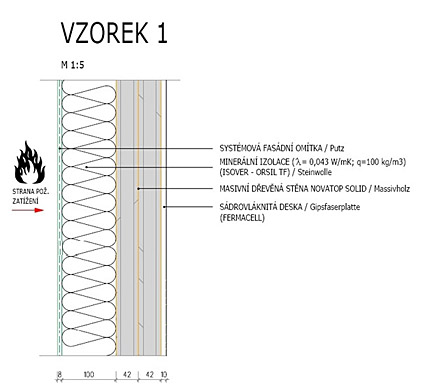 |
| Dimension: | 3000 x 3000 mm |
| Load: | 20 kN/m |
| Fire-loaded side: | exterior |
| Total panel thickness: | 202 mm |
| Composition of the panel from the fire-loaded side: |
|
| 1/ Plaster | thickness = 8 mm |
| 2/ Facade basalt wool | thickness = 100 mm; q = 100 kg/m³; lambda = 0.043 W/mK |
| 3/ NOVATOP Solid | thickness = 84 mm |
| 4/ Fiber cement board | thickness = 10 mm; q = 1000-1250 kg/m³; lambda = 0.32 W/mK (Fermacell) |
TEST RESULT: REI 120 (DP2) e>i
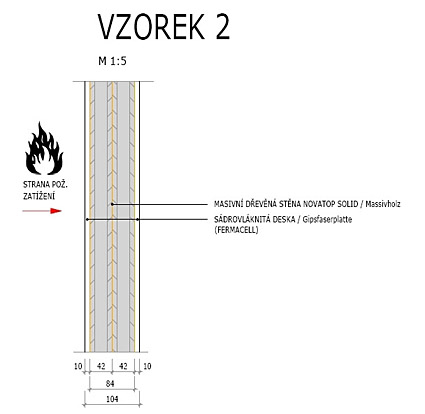 |
| Dimension: | 3000 x 3000 mm |
| Load: | 20 kN/m |
| Fire-loaded side: | not specified - symmetrical composition |
| Total panel thickness: | 104 mm |
| Panel composition: |
|
| 1/ Fiber cement board | thickness = 10 mm; q = 1000-1250 kg/m³; lambda = 0.32 W/mK (Fermacell) |
| 2/ NOVATOP Solid | thickness = 84 mm |
| 3/ Fiber cement board | thickness = 10 mm; q = 1000-1250 kg/m³; lambda = 0.32 W/mK (Fermacell) |
TEST RESULT: REI 15 (DP2) / REI 60 (DP3)
Stanislav MÜLLER, DiS
portal www.drevo-stavba.info
The English translation is powered by AI tool. Switch to Czech to view the original text source.
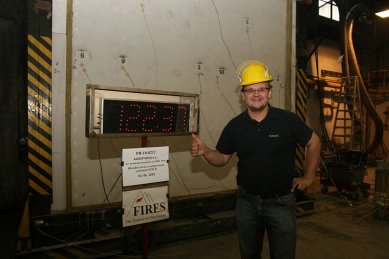
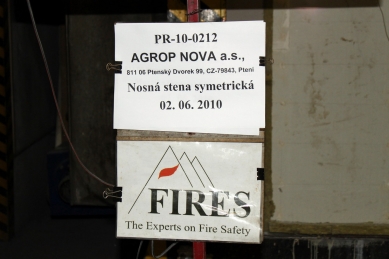
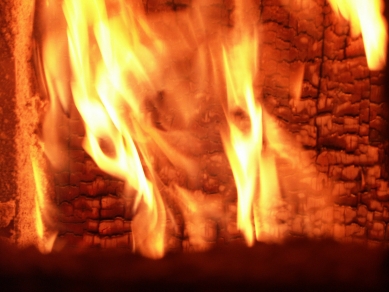
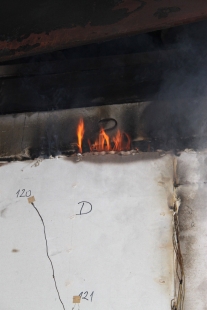
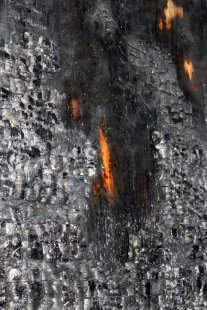
0 comments
add comment







